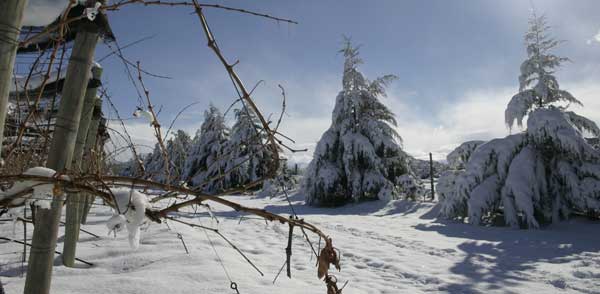HARVEST REPORT – 1998
The climatic phenomenon known as «El Niño», with its characteristics of excessive rains in some regions and droughts in others, expressed itself in Mendoza, the principal viticultural zone of Argentina, with a great deal of rain and humidity.
Spring began with mild temperatures and a good budbreak, with vigorous shoots and an adequate amount of clusters, leading to the expectation of an excellent yield. Later in the season, the region experienced unseasonal rains, favoring bud growth and leading to a very good set, with full, well proportioned clusters. The end of Spring witnessed several strong hail storms, especially in the eastern part of Mendoza, which destroyed much of the lower quality grape production. The storms did not, however, affect the high altitude regions in the foothills of the Andes, home to the quality varietals.
In the month of January, the rains gave way to dry, sunny weather conditions, returning the possibility of an excellent yield. The month of February, however, began with a week of dry, cold weather and continued with three weeks of fairly intense rains which were always followed by cold, cloudy days.
The white varietals, which where starting to ripen and mature fully, began to suffer the effects of rot, causing the initiation of an early harvest before the grapes had reached their optimum level of maturity. This generated musts with mature, but not honeyed, fruit and with a high level of malic acid. Those varietals which were cultivated in sandy, well drained soils matured more completely and, especially in the eastern regions, good juice was produced, leading to distinctive wines, noteworthy for their balance.
In the case of Chardonnay, cultivated in the high altitude regions of the Andean foothills, which are typically cooler and more humid, it was not possible to attain the customary level of concentration, and only in exceptional cases was an optimum maturation achieved. The climatic situation did not allow for late thinning or hang time extension, techniques habitually used to cultivate the fruit for the Catena Alta Chardonnay. As a result, this wine was not produced for the 1998 vintage.
The weather conditions improved in the beginning of March, with warm and sunny days, allowing the red varietals, which had not been adversely affected by February’s rains, to continue maturing normally. At the end of March, however, the rains began again, repeating the problems experienced with the white varietals. In order to avoid rot, the harvest began when the grapes had attained an acceptable level of maturity, without prolonged hang time. This resulted in musts with balanced acidity but with less concentration.
With regard to the different regions of Mendoza, the climatic conditions throughout the year allowed the warmer, eastern section of Mendoza, usually characterized by grapes with high sugar and low acidity, to produce well balanced wines with more highly developed tannins.
The area of San Juan, to the north of Mendoza, usually characterized by wines with high alcohol levels and low acidity also produced more well balanced wines this year. The growing regions in the Andean foothills and the south of Mendoza, characterized as being cooler and more humid, produced fairly acidic wines with low alcohol levels and without great concentration.

With regard to varietals, even though they are also dependent on the zones in which they are produced, one can differentiate some Chenin Blancs with good character, with peach and tropical fruit flavors as well as some Sauvignon Blancs with the distinctive grassy character which is typical of this varietal, a quality which is difficult to achieve in a sunny year.
With respect to the red varietals, it is important to point out the excellent performance of Malbec, which apart from having loose, well spaced clusters, is located in vineyards with clay soils and a moderate slope, allowing for superficial water run off during rains. These characteristics allowed the harvest date to be delayed in order to attain optimum maturation. The 1998 Malbecs reflect this concentration and maturity.
In the case of Cabernet Sauvignon and Merlot, the grapes reached a good level of maturity but the harvest had to be initiated at the first signs of rot, decreasing the hang time. In the eastern section of Mendoza, fairly concentrated and well balanced wines were produced while those of the piedmont are a little green and diluted.
As a conclusion, one can say that the ’98 vintage was the exception to the rule, a completely atypical year which, although not allowing for the production for great wines, has allowed us to confront atypical and unfavorable circumstances and from that increase the knowledge of vineyard behavior and learn the correct management techniques to use in such conditions.
These conclusions are also valid for the enologists, who were forced to confront different conditions with regard to their raw material. From this confrontation, they have had to realize different treatments and experiments in order to achieve an equilibrium and balance different from that to which they were accustomed.